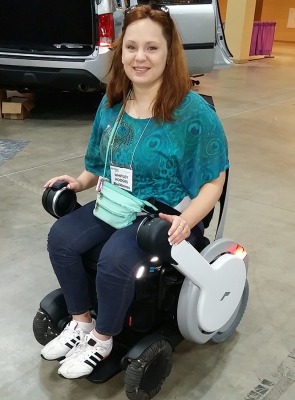
By Gary M. Kaye
Chief Content OfficeTech 50+ (www.tech50plus.com)
We were first introduced to the amazing wheelchairs from Whill (it's pronounced “will”) back in 2015 at CES (The Consumer Electronics Show) in Las Vegas. At the time I recall thinking that if ever I became disabled, this would be the way to go. Unfortunately, complications from chemotherapy recently left me unable to walk for several months. I knew that I would recover but in the meantime, I needed a way to get around. I didn't want a big heavy wheelchair, not even the FDA-approved Whill Model M. What I needed was something portable and a device that would make the tight turns inside my living space. The Whill Ci came to my rescue.
My Whill introduction
For weeks I was unable to get out of bed, giving me plenty of opportunities to research the issue, finally concluding that the Whill Ci offered the best combination of portability and mobility. The Ci is not FDA-approved, so it's not considered a medical device, but rather a personal mobility vehicle. It was first shown at CES earlier this year, and after gathering an armful of design awards, came to market only weeks later. Retail price is about $4,000. That's about half the price of the full-sized Whill but doesn’t give up half the functionality.
If you have an iPhone, the Ci has an available app that will allow you to maneuver the device remotely, and while that scared the daylights out of the staff at my rehab facility, it is a function far more useful than you might imagine. It also comes with a USB charging port.
The manuverability difference
What really sets the Whill apart is its amazing front wheels. Called Omni Wheels, each contains 24 small rollers that allow the Ci to turn in a 30-inch radius. That means you can spin around inside an elevator so you can drive in facing forward turn it and drive out facing forward. Whill offers this explanation of the way they work:
“The omni-directional wheel technology is one of the advanced features of Whill personal EVs that give our products unique capabilities. Conventional omni-directional wheel technology was invented for vehicles such as forklifts and cars but has never been an effective application for wheelchairs and mobility devices due to several design flaws in existing implementations. Seeing these efforts, we believed that the same concept used in these other vehicles could be perfected and ultimately applied to personal mobility to create a revolutionary device.
“The omni-directional wheel engineered by Whill is built using 24 small rollers that collectively create one large wheel. The rollers all move individually, allowing you to glide sideways and achieve a tighter turning radius, while simultaneously providing the greater terrain coverage. Our engineers have tested and refined the Omni Wheel to create a front wheel so sophisticated that it redefines the whole concept of personal mobility. The team’s pride and dedication is evidenced by the attention to detail and countless hours put into this single component on the device. Some may see it as just another wheel, but we see it as the next generation of personal mobility. The fact that Omni Wheels do not need to swivel eliminates the dangers and difficulty often found using swiveling casters. Casters need additional room to rotate before changing direction and as they rotate they can get stuck against walls and cabinets. They can also get tangled up in a user’s feet as they rotate, causing injury.”
Pros and cons
The Whill Ci can be disassembled into four components, the heaviest of which is 46 pounds, so you can take it apart put it in the trunk of your car and reassemble it someplace else. Whill says you can do this in about 10 seconds. Took us a lot longer, but still not a time-consuming project.
But that raises another issue. This is a personal electronic vehicle and not a traditional wheelchair. While someone who is not ambulatory can make use of it, they cannot do the disassembly and reassembly alone.
The Whill Ci uses a directional controller, not unlike a video game, making it very easy to maneuver. It has a width of about 21 inches which means you can get it through most interior door frames. It has up to a 10-mile range and will run for the better part of the day on a single charge. It has three different speeds and gets up to 5 miles an hour.
However, the machine is not perfect for all purposes. It does fine with urban terrain – it clears objects that are two inches high – but has a tough time getting traction on leaves, sand, gravel, snow or mud. It can climb a 10 percent uphill grade and has electromagnetic brakes to slow your descent.
In short, if you are at least partially ambulatory, this is a great way to get out of the house or maneuver inside it. The design is gorgeous, the maneuverability is just about unmatched, and the little touches like the app, arms that get out of the way for easy sitting, and remote locking, make this a great mobility device.
Gary Kaye is the creator of Tech50+ (www.tech50plus.com), the leading website covering technology from the Baby Boomer perspective. Kaye has been covering high tech for more than 30 years with outlets including NBC, ABC, CNN and Fox Business. He is a regular contributor to AARP and other websites on issues regarding the nexus of technology, seniors and baby boomers.